Targeted and Suspect Fatty Acid Profiling of Royal Jelly by Liquid Chromatography—High Resolution Mass Spectrometry
Abstract
1. Introduction
2. Materials and Methods
2.1. Chemicals and Reagents
2.2. Stock and Working Solutions
2.3. Instrumentation
2.4. Sample Preparation
2.5. Method Validation
2.5.1. Linearity and Sensitivity
2.5.2. Precision and Accuracy
2.6. Royal Jelly Samples
3. Results and Discussion
3.1. Accuracy and Precision Data
3.2. Analysis of RJ Samples
3.3. Suspect Analysis
3.4. Discussion
4. Conclusions
Supplementary Materials
Author Contributions
Funding
Institutional Review Board Statement
Informed Consent Statement
Data Availability Statement
Conflicts of Interest
References
- Giampieri, F.; Quiles, J.L.; Cianciosi, D.; Forbes-Hernández, T.Y.; Orantes-Bermejo, F.J.; Alvarez-Suarez, J.M.; Battino, M. Bee products: An emblematic example of underutilized sources of bioactive compounds. J. Agric. Food Chem. 2022, 70, 6833–6848. [Google Scholar] [CrossRef] [PubMed]
- El-Guendouz, S.; Lyoussi, B.; Miguel, M.G. Insight into the chemical composition and biological properties of Mediterranean royal jelly. J. Apic. Res. 2020, 59, 890–909. [Google Scholar] [CrossRef]
- Ramadan, M.F.; Al-Ghamdi, A. Bioactive compounds and health-promoting properties of royal jelly: A review. J. Funct. Foods 2012, 4, 39–52. [Google Scholar] [CrossRef]
- Wei, W.-T.; Hu, Y.-Q.; Zheng, H.-Q.; Cao, L.-F.; Hu, F.-L.; Hepburn, H.R. Geographical influences on content of 10-hydroxy-trans-2-decenoic acid in royal jelly in China. J. Econ. Entomol. 2013, 106, 1958–1963. [Google Scholar] [CrossRef] [PubMed]
- Wongchai, V.; Ratanavalachai, T. Seasonal variation of chemical composition of royal jelly produced in Thailand. Thammasat Int. J. Sci. Technol. 2002, 7, 1–8. [Google Scholar]
- Sabatini, A.G.; Marcazzan, G.L.; Caboni, M.F.; Bogdanov, S.; de Almeida-Muradian, L.B. Quality and standardisation of Royal Jelly. J. ApiProd. ApiMed. Sci. 2009, 1, 1–6. [Google Scholar] [CrossRef]
- Melliou, E.; Chinou, I. Chemistry and bioactivity of royal jelly from Greece. J. Agric. Food Chem. 2005, 53, 8987–8992. [Google Scholar] [CrossRef]
- El-Guendouz, S.; Machado, A.M.; Aazza, S.; Lyoussi, B.; Miguel, M.G.; Mateus, M.C.; Figueiredo, A.C. Chemical characterization and biological properties of royal jelly samples from the Mediterranean area. Nat. Prod. Commun. 2020, 15, 1934578X2090808. [Google Scholar] [CrossRef]
- Pattamayutanon, P.; Peng, C.-C.; Sinpoo, C.; Chantawannakul, P. Effects of pollen feeding on quality of royal jelly. J. Econ. Entomol. 2018, 111, 2974–2978. [Google Scholar] [CrossRef]
- Ma, C.; Ma, B.; Li, J.; Fang, Y. Changes in chemical composition and antioxidant activity of royal jelly produced at different floral periods during migratory beekeeping. Food Res. Int. 2022, 155, 111091. [Google Scholar] [CrossRef]
- Wu, Y.; Zheng, Y.; Li-Byarlay, H.; Shi, Y.; Wang, S.; Zheng, H.; Hu, F. CYP6AS8, a cytochrome P450, is associated with the 10-HDA biosynthesis in honey bee (Apis Mellifera) workers. Apidologie 2020, 51, 1202–1212. [Google Scholar] [CrossRef]
- Collazo, N.; Carpena, M.; Nuñez-Estevez, B.; Otero, P.; Simal-Gandara, J.; Prieto, M.A. Health promoting properties of bee royal jelly: Food of the queens. Nutrients 2021, 13, 543. [Google Scholar] [CrossRef]
- Khazaei, M.; Ansarian, A.; Ghanbari, E. New findings on biological actions and clinical applications of royal jelly: A review. J. Diet. Suppl. 2018, 15, 757–775. [Google Scholar] [CrossRef]
- Filipič, B.; Gradišnik, L.; Rihar, K.; Šooš, E.; Pereyra, A.; Potokar, J. The influence of royal jelly and human interferon-alpha (HuIFN-AN3) on proliferation, glutathione level and lipid peroxidation in human colorectal adenocarcinoma cells in vitro. Arh. Hig. Toksikol. 2015, 66, 269–274. [Google Scholar] [CrossRef]
- Šedivá, M.; Laho, M.; Kohútová, L.; Mojžišová, A.; Majtán, J.; Klaudiny, J. 10-HDA, a major fatty acid of royal jelly, exhibits pH dependent growth-inhibitory activity against different strains of paenibacillus larvae. Molecules 2018, 23, 3236. [Google Scholar] [CrossRef]
- Pan, Y.; Xu, J.; Jin, P.; Yang, Q.; Zhu, K.; You, M.; Hu, F.; Chen, M. Royal jelly ameliorates behavioral deficits, cholinergic system deficiency, and autonomic nervous dysfunction in ovariectomized cholesterol-fed rabbits. Molecules 2019, 24, 1149. [Google Scholar] [CrossRef]
- You, M.M.; Liu, Y.C.; Chen, Y.F.; Pan, Y.M.; Miao, Z.N.; Shi, Y.Z.; Si, J.J.; Chen, M.L.; Hu, F.L. Royal jelly attenuates nonalcoholic fatty liver disease by inhibiting oxidative stress and regulating the expression of circadian genes in ovariectomized rats. J. Food Biochem. 2020, 44, e13138. [Google Scholar] [CrossRef]
- Chen, Y.-F.; Wang, K.; Zhang, Y.-Z.; Zheng, Y.-F.; Hu, F.-L. In vitro anti-inflammatory effects of three fatty acids from royal jelly. Mediat. Inflamm. 2016, 2016, 3583684. [Google Scholar] [CrossRef]
- Moutsatsou, P.; Papoutsi, Z.; Kassi, E.; Heldring, N.; Zhao, C.; Tsiapara, A.; Melliou, E.; Chrousos, G.P.; Chinou, I.; Karshikoff, A.; et al. Fatty acids derived from royal jelly are modulators of estrogen receptor functions. PLoS ONE 2010, 5, e15594. [Google Scholar] [CrossRef]
- Antinellia, J.-F.; Zeggane, S.; Davico, R.; Rognonea, C.; Faucon, J.-P.; Lizzani, L. Evaluation of (E)-10-hydroxydec-2-enoic acid as a freshness parameter for royal jelly. Food Chem. 2003, 80, 85–89. [Google Scholar] [CrossRef]
- Zhou, J.; Zhao, J.; Yuan, H.; Meng, Y.; Li, Y.; Wu, L.; Xue, X. Comparison of UPLC and HPLC for determination of trans-10-hydroxy-2-decenoic acid content in royal jelly by ultrasound-assisted extraction with internal standard. Chromatographia 2007, 66, 185–190. [Google Scholar] [CrossRef]
- Ferioli, F.; Marcazzan, G.L.; Caboni, M.F. Determination of (E)-10-hydroxy-2-decenoic acid content in pure royal jelly: A comparison between a new CZE method and HPLC. J. Sep. Sci. 2007, 30, 1061–1069. [Google Scholar] [CrossRef] [PubMed]
- Isidorov, V.A.; Bakier, S.; Grzech, I. Gas chromatographic–mass spectrometric investigation of volatile and extractable compounds of crude royal jelly. J. Chromatogr. B 2012, 885, 109–116. [Google Scholar] [CrossRef] [PubMed]
- Isidorov, V.A.; Czyzewska, U.; Isidorova, A.G.; Bakier, S. Gas chromatographic and mass spectrometric characterization of the organic acids extracted from some preparations containing lyophilized royal jelly. J. Chromatogr. B 2009, 877, 3776–3780. [Google Scholar] [CrossRef] [PubMed]
- Ferioli, F.; Armaforte, E.; Caboni, M.F. Comparison of the lipid content, fatty acid profile and sterol composition in local Italian and commercial royal jelly samples. J. Am. Oil Chem. Soc. 2014, 91, 875–884. [Google Scholar] [CrossRef]
- Ibrahim, R.S.; El-Banna, A.A. Royal jelly fatty acids bioprofiling using TLC-MS and digital image analysis coupled with chemometrics and non-parametric regression for discovering efficient biomarkers against melanoma. RSC Adv. 2021, 11, 18717–18728. [Google Scholar] [CrossRef]
- Yan, S.; Wang, X.; Sun, M.; Wang, W.; Wu, L.; Xue, X. Investigation of the lipidomic profile of royal jelly from different botanical origins using UHPLC-IM-Q-TOF-MS and GC-MS. LWT 2022, 169, 113894. [Google Scholar] [CrossRef]
- Kokotou, M.G.; Mantzourani, C.; Babaiti, R.; Kokotos, G. Study of the royal jelly free fatty acids by liquid chromatography-high resolution mass spectrometry (LC-HRMS). Metabolites 2020, 10, 40. [Google Scholar] [CrossRef]
- Kokotou, M.G.; Mantzourani, C.; Kokotos, G. Development of a liquid chromatography-high resolution mass spectrometry method for the determination of free fatty acids in milk. Molecules 2020, 25, 1548. [Google Scholar] [CrossRef]
- Jia, W.; Shi, L.; Chu, X. Untargeted screening of sulfonamides and their metabolites in salmon using liquid chromatography coupled to quadrupole Orbitrap mass spectrometry. Food Chem. 2018, 239, 427–433. [Google Scholar] [CrossRef]
- Gauglitz, J.M.; Aceves, C.M.; Aksenov, A.A.; Aleti, G.; Almaliti, J.; Bouslimanim, A.; Brown, E.A.; Campeau, A.; Caraballo-Rodríguez, A.M.; Chaar, R.; et al. Untargeted mass spectrometry-based metabolomics approach unveils molecular changes in raw and processed foods and beverages. Food Chem. 2020, 302, 125290. [Google Scholar] [CrossRef]
- Kokotou, M.G.; Kokotos, A.C.; Gkikas, D.; Mountanea, O.G.; Mantzourani, C.; Almutairi, A.; Lei, X.; Ramanadham, S.; Politis, P.K.; Kokotos, G. Saturated hydroxy fatty acids exhibit a cell growth inhibitory activity and suppress the cytokine-induced β-cell apoptosis. J. Med. Chem. 2020, 63, 12666–12681. [Google Scholar] [CrossRef]
- Mantzourani, C.; Batsika, C.S.; Kokotou, M.G.; Kokotos, G. Free fatty acid profiling of Greek yogurt by liquid chromatography-high resolution mass spectrometry (LC-HRMS) analysis. Food Res Int. 2022, 160, 111751. [Google Scholar] [CrossRef]
- Kokotou, M.G.; Mantzourani, C.; Bourboula, A.; Mountanea, O.G.; Kokotos, G. A liquid chromatography-high resolution mass spectrometry (LC-HRMS) method for the determination of free hydroxy fatty acids in cow and goat milk. Molecules 2020, 25, 3947. [Google Scholar] [CrossRef]
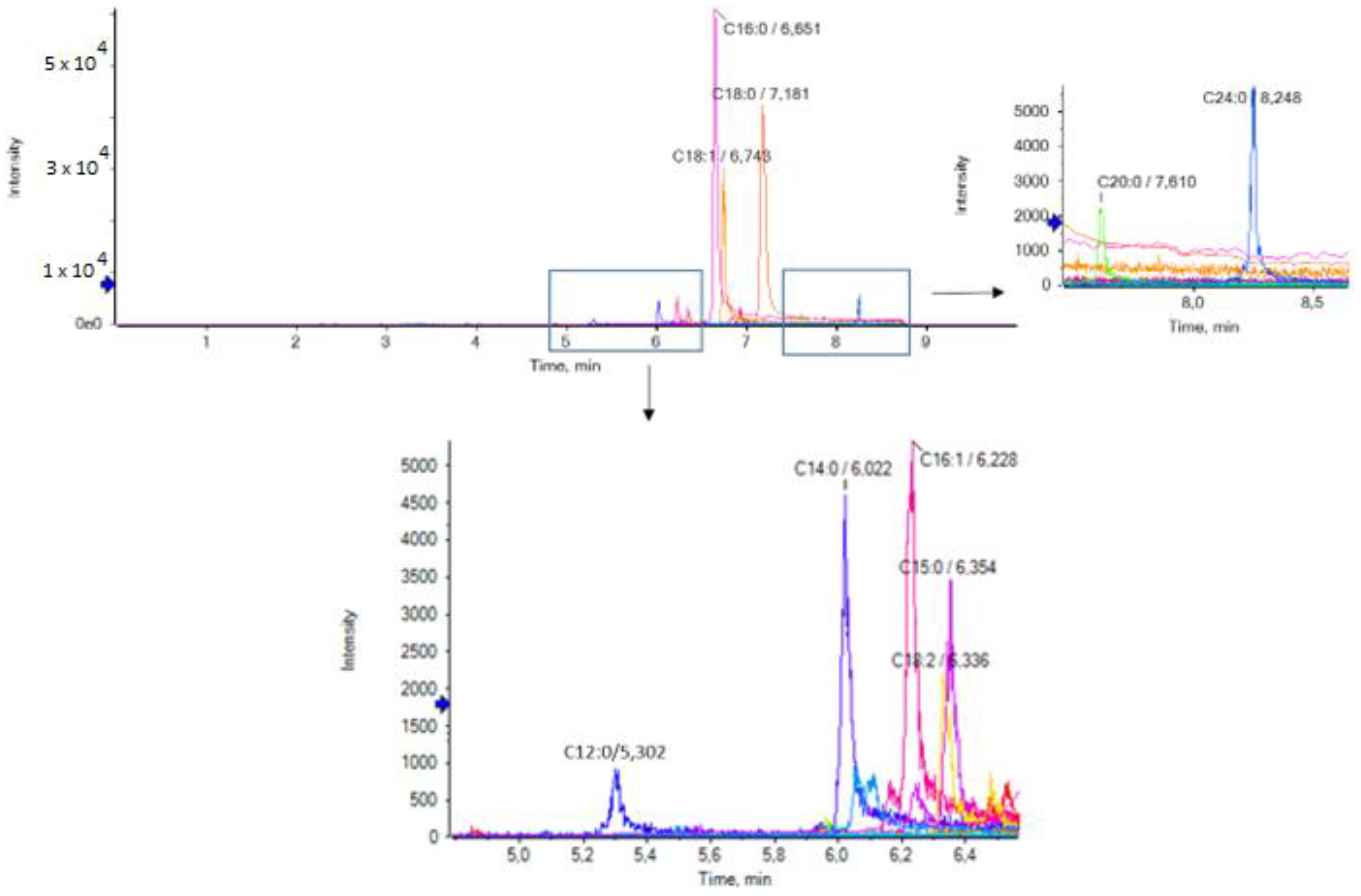
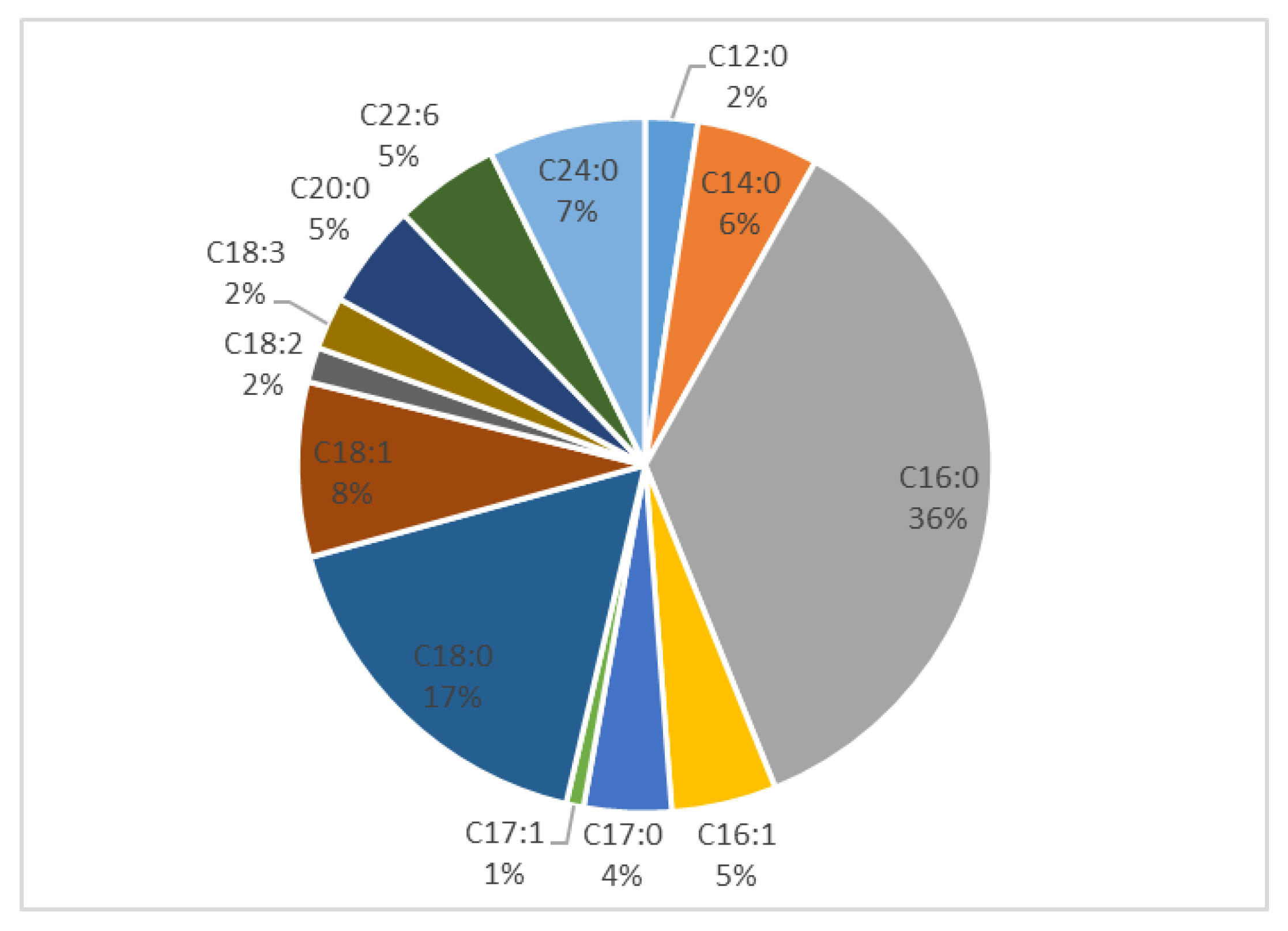
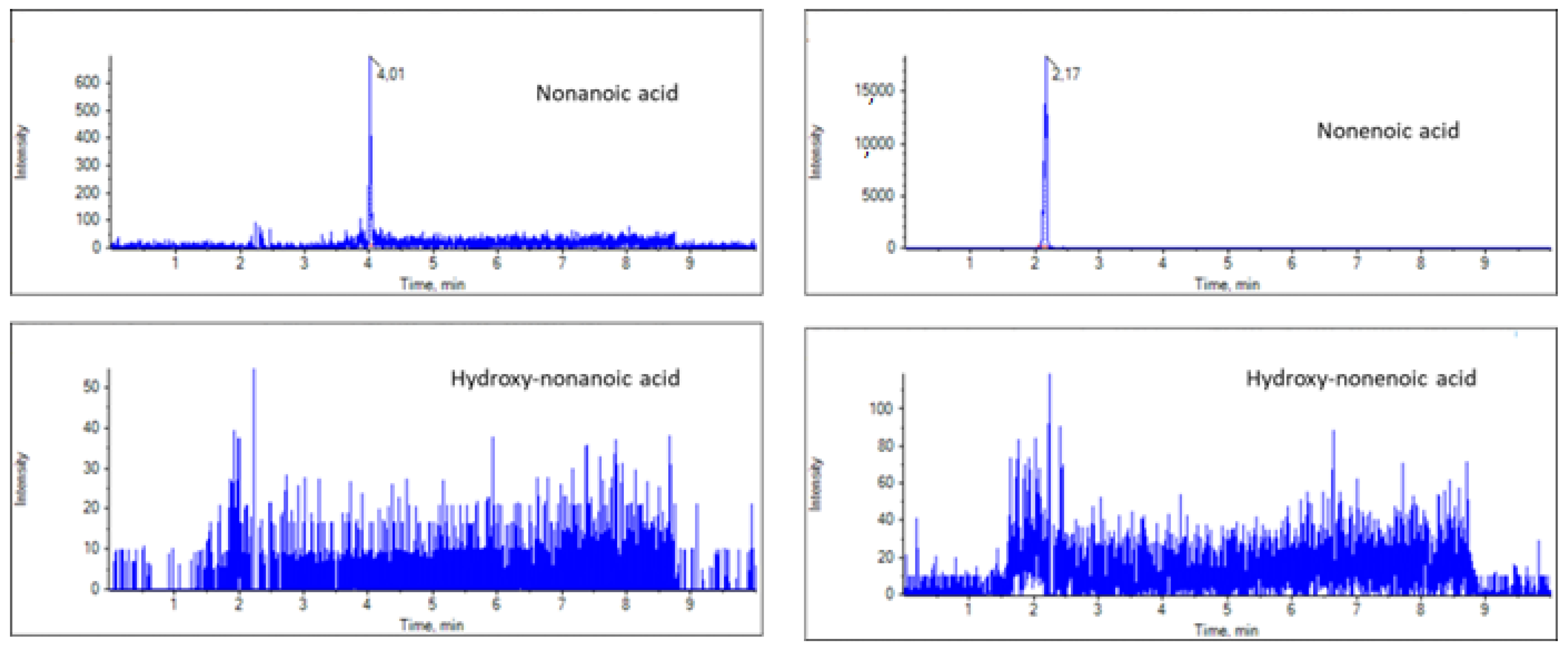
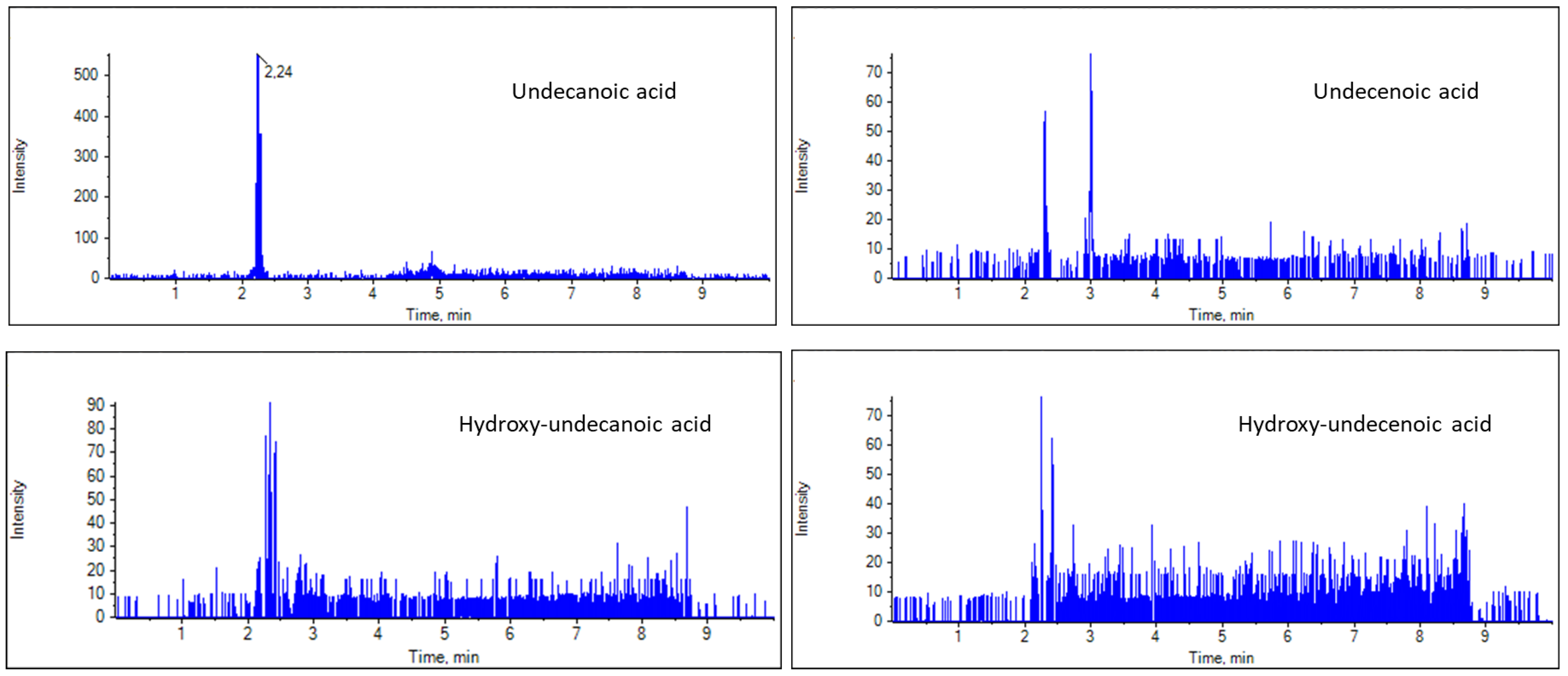
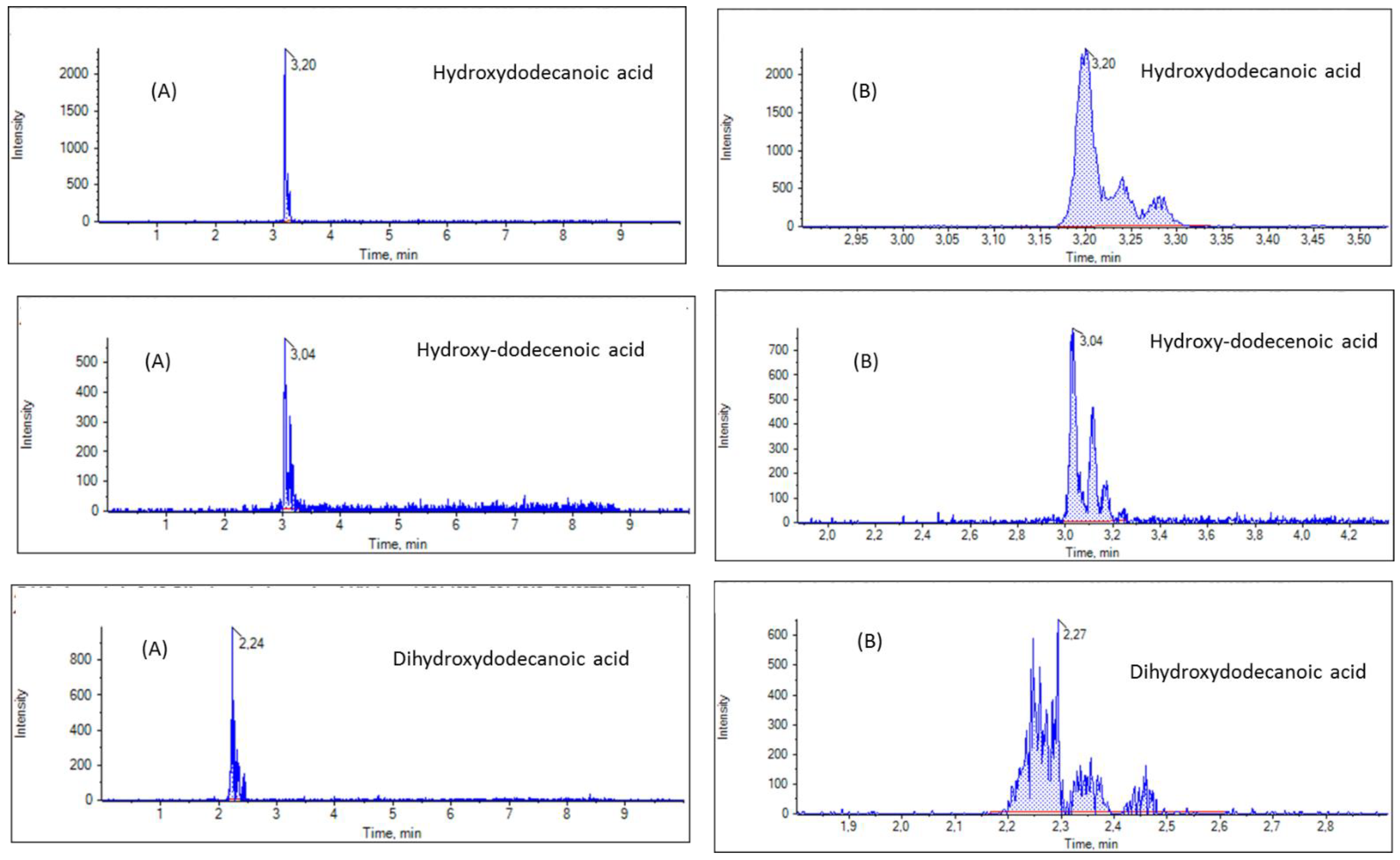

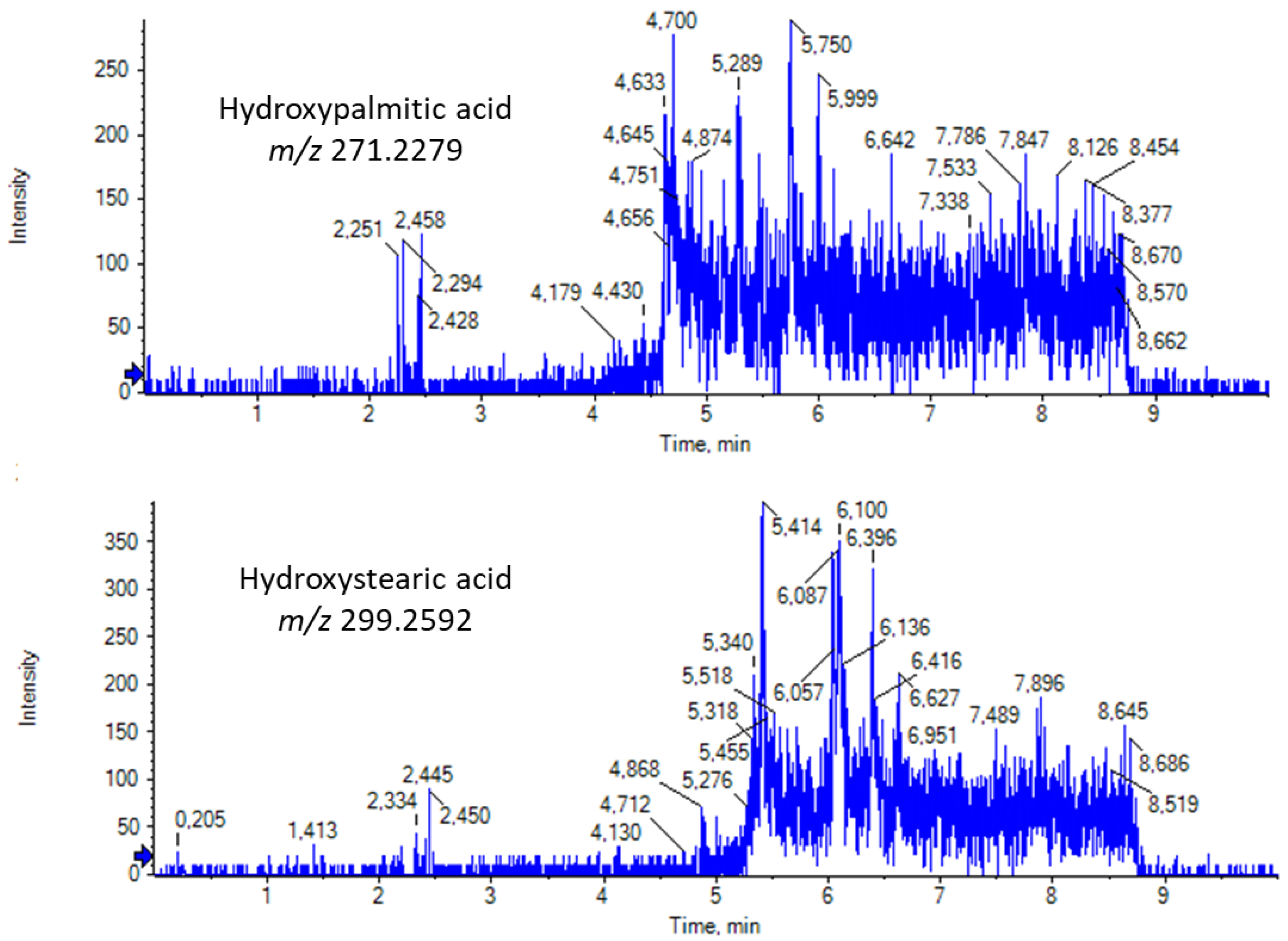
| Free Fatty Acid | Royal Jelly Samples (n = 7), Triplicates | |||
|---|---|---|---|---|
| Minimum Value (mg/100 g RJ) | Maximum Value (mg/100 g RJ) | Mean Value ± SD (mg/100 g RJ) | α | |
| C12:0 | 2.3 | 3.1 | 2.6± 0.3 | *** |
| C14:0 | 4.8 | 8.4 | 6.5± 0.5 | *** |
| C14:1 | <LOQ | <LOQ | <LOQ | - |
| C15:0 | <LOQ | <LOQ | <LOQ | - |
| C16:0 | 37.4 | 48.0 | 43.7 ± 3.9 | *** |
| C16:1 | 5.3 | 6.0 | 5.6 ± 0.2 | *** |
| C17:0 | 4.3 | 6.4 | 5.3 ± 0.7 | *** |
| C17:1 | 1.0 | 1.4 | 1.2 ± 0.1 | *** |
| C18:0 | 17.7 | 24.0 | 20.9 ± 2.1 | *** |
| C18:1 | 9.4 | 11.1 | 10.1 ± 0.6 | *** |
| C18:2 | 1.3 | 1.7 | 1.5 ± 0.1 | *** |
| C18:3 | 1.6 | 4.6 | 3.0 ± 0.5 | *** |
| C20:0 | 4.5 | 7.0 | 5.6 ± 0.9 | *** |
| C20:3 | ND | ND | ND | - |
| C20:4 | ND | ND | ND | - |
| C20:5 | ND | ND | ND | - |
| C22:4 | ND | ND | ND | - |
| C22:5 | ND | ND | ND | - |
| C22:6 | 4.6 | 7.0 | 5.8 ± 0.9 | *** |
| C24:0 | 8.5 | 10.6 | 9.2 ± 0.6 | *** |
| Compound | Theoretical Mass [M − H]− | Measured Mass [M − H]− | Mass Error (ppm) | Elemental Composition | MS Rank a | Content Relative to C16:0 (%) b |
|---|---|---|---|---|---|---|
| Nonanoic acid | 157.1234 | 157.1230 | 2.6 | C8H18O2 | 1/1 | 3 ± 0.5 |
| Nonenoic acid | 155.1078 | 155.1077 | 0.6 | C9H16O2 | 1/1 | 71 ± 9.1 |
| Undecanoic acid | 185.1547 | 185.1540 | 3.8 | C11H22O2 | 1/1 | 1 ± 0.1 |
| Hydroxydodecanoic acid | 215.1653 | 215.1650 | 1.4 | C12H24O3 | 1/1 | 10 ± 2.5 |
| Hydroxydodecenoic acid | 213.1496 | 213.1493 | 1.4 | C12H22O3 | 1/1 | 4 ± 0.9 |
| Dihydroxydodecanoic acid | 231.1602 | 231.1600 | 0.9 | C12H24O4 | 1/1 | 4 ± 0.9 |
Disclaimer/Publisher’s Note: The statements, opinions and data contained in all publications are solely those of the individual author(s) and contributor(s) and not of MDPI and/or the editor(s). MDPI and/or the editor(s) disclaim responsibility for any injury to people or property resulting from any ideas, methods, instructions or products referred to in the content. |
© 2023 by the authors. Licensee MDPI, Basel, Switzerland. This article is an open access article distributed under the terms and conditions of the Creative Commons Attribution (CC BY) license (https://creativecommons.org/licenses/by/4.0/).
Share and Cite
Mantzourani, C.; Kokotou, M.G. Targeted and Suspect Fatty Acid Profiling of Royal Jelly by Liquid Chromatography—High Resolution Mass Spectrometry. Biomolecules 2023, 13, 424. https://doi.org/10.3390/biom13030424
Mantzourani C, Kokotou MG. Targeted and Suspect Fatty Acid Profiling of Royal Jelly by Liquid Chromatography—High Resolution Mass Spectrometry. Biomolecules. 2023; 13(3):424. https://doi.org/10.3390/biom13030424
Chicago/Turabian StyleMantzourani, Christiana, and Maroula G. Kokotou. 2023. "Targeted and Suspect Fatty Acid Profiling of Royal Jelly by Liquid Chromatography—High Resolution Mass Spectrometry" Biomolecules 13, no. 3: 424. https://doi.org/10.3390/biom13030424
APA StyleMantzourani, C., & Kokotou, M. G. (2023). Targeted and Suspect Fatty Acid Profiling of Royal Jelly by Liquid Chromatography—High Resolution Mass Spectrometry. Biomolecules, 13(3), 424. https://doi.org/10.3390/biom13030424







